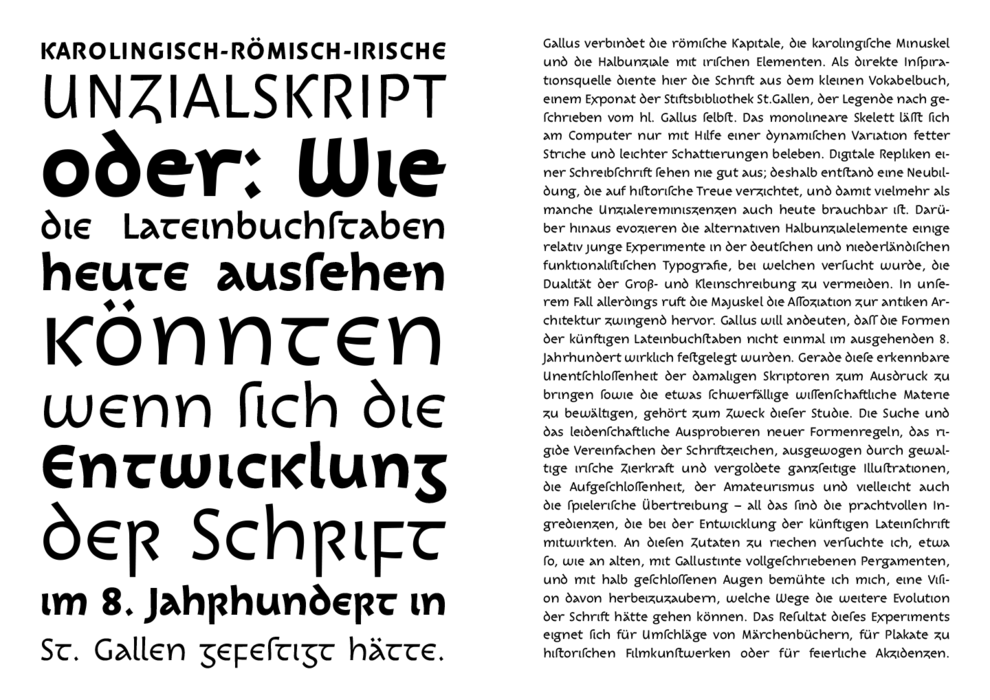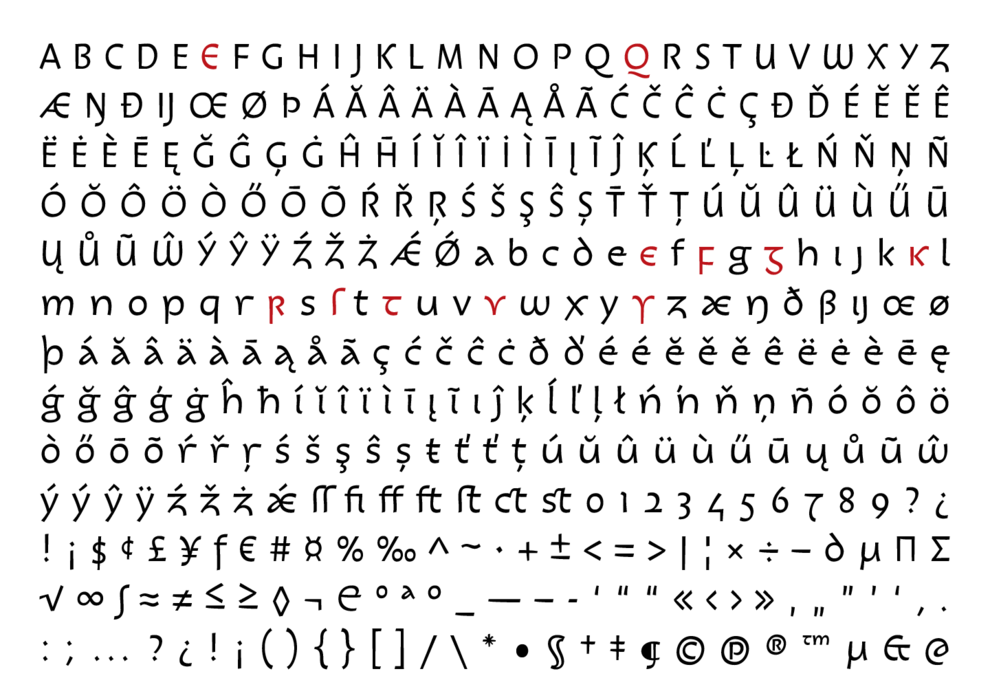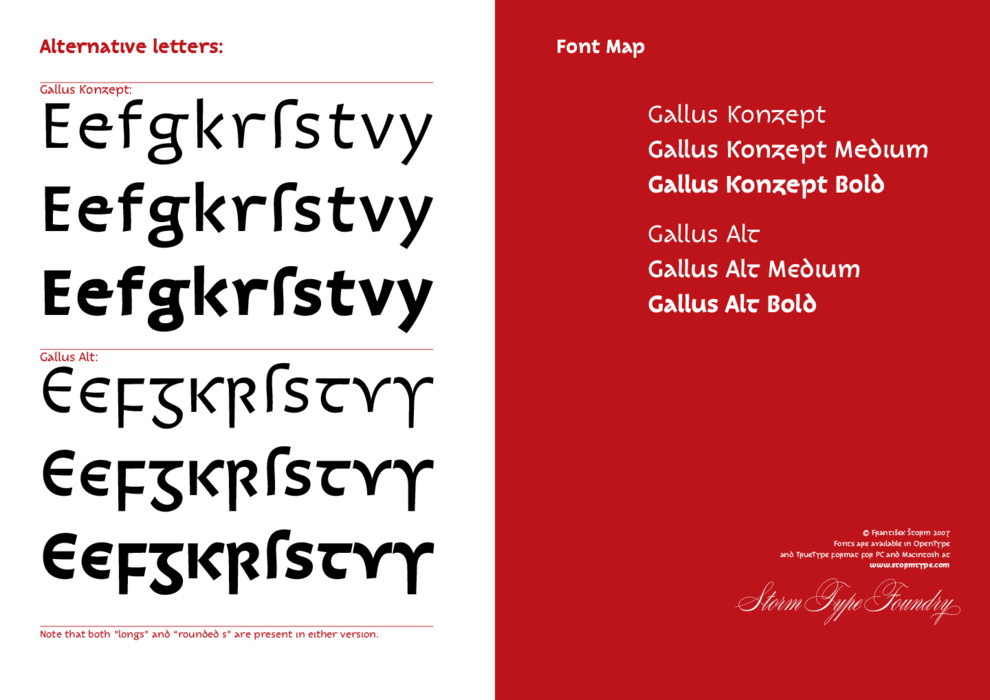Gallus Konzept
- Typefaces
- Gallery
Gallus Konzept
by František ŠtormCarolingian-Roman-Gaelic-Uncial script. Or an exploration into how the Latin alphabet could look were the evolution of the Carolingian Minuscule to stop in the 8th century AD in Sankt Gallen. During one of our study trips tracking the history of type, we visited the convent library of Sankt Gallen in Switzerland. There, rare manuscripts from the 7th through the 9th century AD are kept, documenting the variety of forms of hand-written script. Apart from the apparent influence of Carolingian minuscule, an inspiration of Roman uncial and majuscule is also clear, as well as the traces of Gaelic ornaments. Certain abbot Hartmut even lend his name to one modified form of Carolingian script which embodies all the above mentioned inspirations and principles, thus documenting that as late as at the end of the 8th century, it was not clear how the future Latin alphabet was going to look. Thanks to the Stiftsbibliotek St. Gallen, selected works are available in high resolution on the internet at http://www.cesg.unifr.ch/virt_bib/manuscripts.htm. Direct inspiration for our digital alphabet came in the form of a small travel vocabulary of some unknown monk, possibly Saint Gallen himself. Here, the characters are adjusted to the limited format and speed of writing and thus presented in the simplest form possible, which remains charming and legible up to this day. Alternatively, I added some common shapes of the minuscule. The present-day uncial scripts, runes or blackletter alphabets are often marred with the burden of the local, being a historically true transcripts of a given template, bound by official typographic rules. The goal of our study was to express the indecisiveness present in all scribes‘ workshops throughout the 8th century, and to forget the heavy yoke of purely scientific approach to the matter. The process of searching for answers, the passionate trials and errors, the striving for new form, the rigid simplification of letters balanced by wild Gaelic ornaments and full page, gold-plated illustrations, the unfinished character of all this, amateurism, and even playful hyperbole - all these are the unique ingredients used in the smelting of a future Latin script. I attempted to smell it just as one smells an old parchment covered with letters written in iron gall ink, to close one‘s eyes and try to imagine where the evolution could possibly take us to. The result of this experiment may be used for fairy-tale book covers, posters for historic films, or an occasional rare print. Karolinsko-římsko-irskounciální skript neboli jak mohla vypadat latinková abeceda kdyby se vývoj karolinské minuskuly ustálil v 8. století v St. Gallen.
Na studijní cestě za historií typografie jsme se letos dostali i do kláštení knihovny ve švýcarském Sankt Gallen. Tam se uchovávají vzácné rukopisy ze 7. až 9. století, které ukazují různé formy psacího písma. Kromě jasného vlivu karolinské minuskuly můžeme zde rozeznati inspiraci římskou unciálou a majuskulou, ale i přítomnost irského ornamentu. Podle jistého opata Hartmuta je dokonce pojmenována určitá modifikovaná forma karolinská, která v sobě všechny jmenované vlivy spojuje. Dokládá, že ani koncem 8. století ještě nebyly pevně rozhodnuty tvary budoucí latinkové abecedy. Péčí Stiftsbibliothek St. Gallen jsou na internetu vybraná díla štědře publikována ve vynikajícím rozlišení: http://www.cesg.unifr.ch/virt_bib/manuscripts.htm . Přímým inspiračním zdrojem pro tuto digitální abecedu je malý cestovní slovníček některého řeholníka, snad i Sv. Galla. V něm jsou znaky kvůli formátu a rychlosti psaní redukovány na nejjednodušší kostru, která je dodnes půvabná a čitelná. Alternativně jsem připojil i obvyklejší tvary některých minusek. Současným unciálám, runám a švabachům se vždy nedaří beze zbytku odfiltrovat častý závoj lokální příslušnosti, jsou to zpravidla historicky věrné transkripce s úředními typologickými ostruhami. Cílem této studie je však vyjádřit onu nerozhodnutost, která se okolo 8. století ve skriptoriích vyskytovala, zapomenout na těžkopádný vědecký materiál. Hledání a vášnivé zkoušení nových tvarosloví, rigidní zjednodušování znaků vyvažované bujnou irskou zdobností a zlacenými celostránkovými ilustracemi, neukončenost, amatérství a snad i hravá nadsázka – to všechno byly skvostné ingredience použité při tavbě budoucího latinkového písma. Pokusil jsem se k nim přivonět tak jako ke starým pergamenům popsaným duběnkovým inkoustem, a s očima přivřenýma si představit, kudy by se asi další vývoj ubíral. Výsledek tohoto experimentu lze použít na obálky pohádkových knížek, plakáty k historickým filmům a příležitostné slavnostní tiskoviny.


